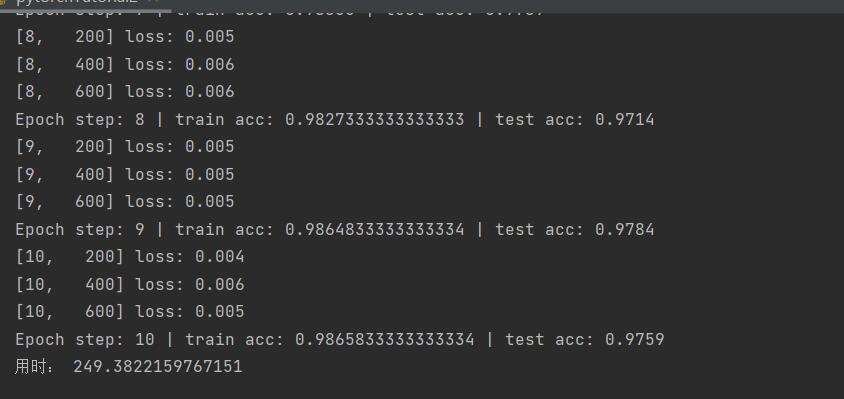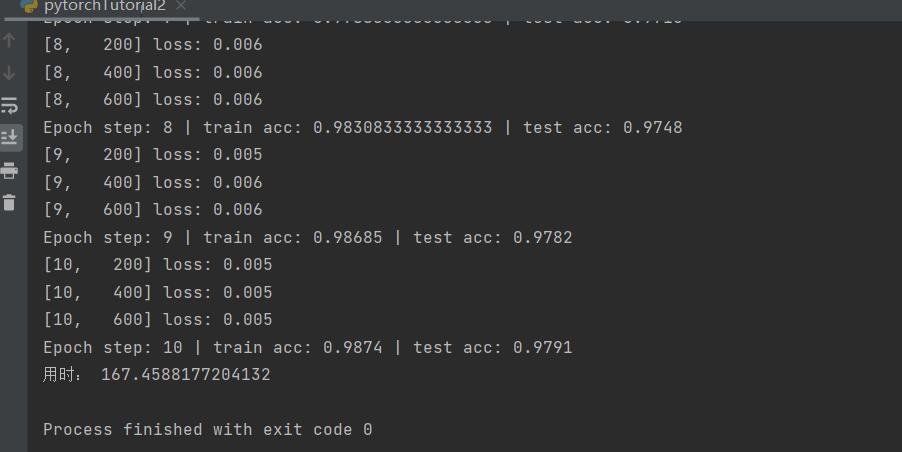1
2
3
4
5
6
7
8
9
10
11
12
13
14
15
16
17
18
19
20
21
22
23
24
25
26
27
28
29
30
31
32
33
34
35
36
37
38
39
40
41
42
43
44
45
46
47
48
49
50
51
52
53
54
55
56
57
58
59
60
61
62
63
64
65
66
67
68
69
70
71
72
73
74
75
76
77
78
79
80
81
82
83
84
85
86
87
88
89
90
91
92
93
94
95
96
97
98
99
100
101
102
103
104
105
106
107
108
109
110
111
112
113
114
115
116
117
118
119
120
121
122
123
124
| import torch
import torch.nn as nn
import torch.optim as optim
import torch.nn.functional as F
import numpy as np
import matplotlib.pyplot as plt
import torch.utils.data as Data
import torchvision
import torchvision.transforms as transforms
import time
batch_size = 100
learning_rate = 0.01
momentum = 0.9
epoch_loop = 10
transform = transforms.Compose(
[transforms.ToTensor(),
transforms.Normalize((0.1307,), (0.3081,))]
)
trainSet = torchvision.datasets.MNIST(
root='./mnist',
train=True,
download=True,
transform=transform
)
trainLoader = Data.DataLoader(trainSet,
batch_size=batch_size,
shuffle=True,
num_workers=0)
testSet = torchvision.datasets.MNIST(
root='./mnist',
train=False,
download=True,
transform=transform
)
testLoader = Data.DataLoader(testSet,
batch_size=batch_size,
shuffle=True,
num_workers=0)
device = torch.device('cuda:0' if torch.cuda.is_available() else 'cpu')
def imshow(img):
img = img / 2 + 0.5
npimg = img.numpy()
plt.imshow(np.transpose(npimg, (1, 2, 0)))
plt.show()
class Net(nn.Module):
def __init__(self):
super(Net, self).__init__()
self.conv1 = nn.Conv2d(1,1,5)
self.pool = nn.MaxPool2d(2,2)
self.fc1 = nn.Linear(144,100)
self.fc2 = nn.Linear(100,10)
def forward(self, x):
x = self.conv1(x)
x = F.relu(x)
x = self.pool(x)
x = x.view(batch_size, -1)
x = self.fc1(x)
x = F.relu(x)
x = self.fc2(x)
return x
net = Net()
criterion = nn.CrossEntropyLoss()
optimizer = optim.SGD(net.parameters(), lr=learning_rate, momentum=0.9)
net.to(device)
startTime = time.time()
for epoch in range(epoch_loop):
running_loss = 0.0
for step, data in enumerate(trainLoader):
inputs, labels = data[0].to(device), data[1].to(device)
optimizer.zero_grad()
outputs = net(inputs)
loss = criterion(outputs, labels)
loss.backward()
optimizer.step()
running_loss += loss.item()
if step % 200 == 199:
print('[%d, %5d] loss: %.3f' % (epoch + 1, step + 1, running_loss / 2000))
running_loss = 0.0
test_acc = 0
test_count = 0
train_acc = 0
train_count = 0
with torch.no_grad():
for data in iter(testLoader):
images, labels = data[0].to(device), data[1].to(device)
outputs = net(images)
_, predictions = torch.max(outputs, 1)
test_acc += torch.sum(predictions == labels)
test_count += len(labels)
for data in iter(trainLoader):
images, labels = data[0].to(device), data[1].to(device)
outputs = net(images)
_, predictions = torch.max(outputs, 1)
train_acc += torch.sum(predictions == labels)
train_count += len(labels)
test_acc = float(test_acc) / test_count
train_acc = float(train_acc) / train_count
print(f'Epoch step: {epoch + 1} | train acc: {train_acc} | test acc: {test_acc}')
endTime = time.time()
print("用时:", (endTime - startTime))
torch.save(net, "mnistCNNTrain.pkl")
torch.save(net.state_dict(), "mnistCNNTrainDict.pth")
|


